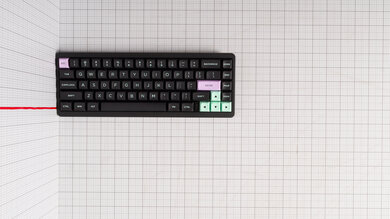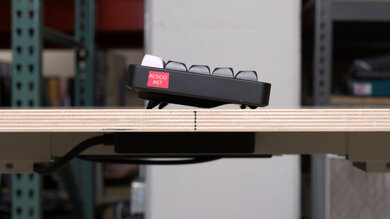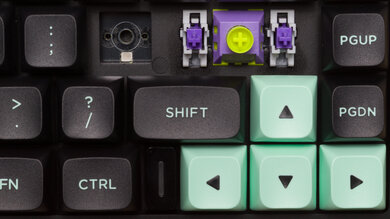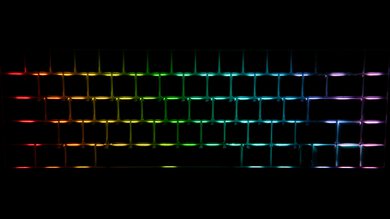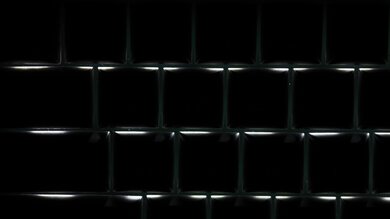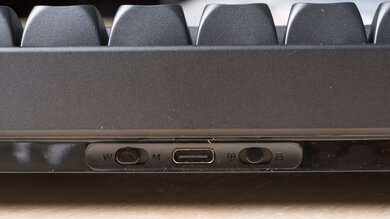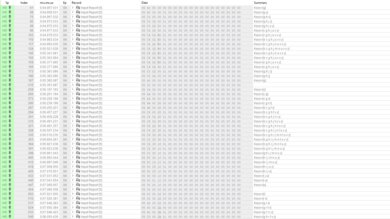The Aesco A67/A83 are wireless gaming keyboards that use inductive switches, which detect keystrokes by sensing changes in the magnetic field via electromagnetic coils embedded in the PCB. This design allows for per-key customization of actuation and reset points, much like Hall effect keyboards. According to Aesco, their inductive switches offer more precise control and significantly better power efficiency than Hall effect alternatives. You can configure a range of expected settings, including RGB lighting and macros, with the Aesco configuration software. You can also adjust more advanced settings, such as Rapid Trigger, SOCD, and DKS.
Our Verdict
The Aesco A67 and A83 are excellent gaming keyboards. They deliver extensive software customization, ultra-low latency, exceptional input granularity, and fully customizable actuation to suit competitive gaming. Their build quality is excellent, with a gasket-mount design and durable PBT keycaps that provide outstanding stability and minimal flex. The per-key RGB backlighting offers extensive customization options, although brightness can be limited in bright environments. The software also provides plenty of customization options with expected actuation settings as well as functions such as SOCD, mod tap, and DKS (dynamic keystrokes).
Very low latency.
Supports a maximum polling rate of 8,000Hz.
Very precise and customizable key switches with barely any deadzone.
Feature-rich software that includes precise actuation settings, and advanced functions such as Rapid Trigger, SOCD, and DKS.
Dim backlighting and lack of shine-through legends.
While the Aesco A67 and A83 keyboards aren't designed specifically with office use in mind, they're decent for office work. Although the typing quality is excellent, thanks to very stable and lubricated switches, the Kailh Pop Pro switches are a bit on the noisy side for use in a quiet office. The higher profile and somewhat heavy keystrokes can also cause fatigue over long office sessions, especially without a wrist rest. The A83 variant does offer a dedicated function row and additional keys like Delete and Insert, which can be useful for some workflows.
Excellent typing experience, with stable pre-lubed switches.
Dim backlighting and lack of shine-through legends.
A bit noisy.
The Aesco A67 and A83 keyboards don't have Bluetooth and aren't suitable for use with mobile devices or tablets.
The Aesco A67/A83 keyboards are a decent choice for programming. They offer excellent build quality and a satisfying typing experience. However, the switches may be on the heavier side for some, which may cause fatigue during extended sessions. The switches are also somewhat noisy. The software allows you to record macros to any key. The keyboards also feature RGB lighting, but it's very dim, and the keycaps lack shine-through legends, making it difficult to see the key legends in low-light environments.
Excellent typing experience, with stable pre-lubed switches.
Dim backlighting and lack of shine-through legends.
A bit noisy.
The Aesco A67/A83 keyboards really aren't well suited for HTPC use. While they connect wirelessly with an included 2.4GHz receiver, they don't support Bluetooth for multi-device pairing. They're also heavy and lack dedicated media keys. Their backlighting is weak, and they lack shine-through legends.
Dim backlighting and lack of shine-through legends.
The Aesco A67 and A83 keyboards offer excellent raw performance, with very low and consistent latency that makes them ideal for competitive gaming. When using the included extender, wireless performance is nearly indistinguishable from wired, ensuring stable and reliable data transmission. However, gamers who frequently press multiple keys simultaneously may find their chord split performance lacking, making it less suitable for those specific use cases.
Very low latency.
Supports a maximum polling rate of 8,000Hz.
Very precise and customizable key switches with barely any deadzone.
Changelog
- Updated Oct 02, 2025: Our 1.4.2 Test Bench Update makes changes to the Hardware Customizability test group. We've created a new Magnetic Switch Compatibility test and renamed our previous PCB Socket test to Mechanical Switch Compatibility. See our full changelog.
- Updated Aug 26, 2025: We've converted this review to Test Bench 1.4.1. This update removes the Key Release test and a video element from the Multi-Key Latency section, resulting in minor score changes. See our full 1.4.1 changelog for details.
- Updated Jun 20, 2025: Review published.
- Updated Jun 11, 2025: Early access published.
Check Price
Differences Between Sizes And Variants
The Aesco A67/A83 come in two size variants and two colorways. The Aesco A67 features a compact 65% layout with a relatively standard profile. The A83 variant is a bit deeper as it includes all the same features but adds a dedicated function row along with additional keys like Delete and Insert. You can check out the Dimensions section for more details.
We bought and tested the Aesco A67 version in black with Kailh Pop Switch Pro inductive switches. See a photo of our unit's label.
| Name | Size | Colorway | Switch Options* |
|---|---|---|---|
| Aesco A67 | Compact (65%) | Black/White | Kailh Pop Switch Pro |
| Aesco A83 | Compact (75%) | Black/White | Kailh Pop Switch Pro |
*While some of Aesco's advertising material suggests there are other switch options available, we've only encountered listings available with Kailh Pop Switch Pro switches.
If you encounter any keyboard variants or listings of other switch options, let us know in the comments.
Popular Keyboard Comparisons
The Aesco A67 and A83 are wireless gaming keyboards that use inductive switches. They are among the first modern models to adopt a new generation of inductive switches, which offer actuation adjustability similar to Hall effect keyboards. The parent company Rapoo claims that these switches provide more accuracy and drastically improved battery efficiency compared to Hall effect switches. In our testing, the switches proved to be highly accurate, though not dramatically more accurate than the best Hall effect switches we've tested. That said, they do manage to provide impressive battery life, thanks in part to the massive 10,000 mAh battery, while delivering top-notch performance at an 8,000Hz polling rate.
These keyboards stand out as an appealing choice due to their wireless flexibility. Impressively, their raw performance nearly rivals that of premium wired-only flagship models like the NuPhy Air60 HE, the Razer Huntsman V3 Pro, and both the Wooting 60HE and Wooting 80HE. Its software is also quite complete, even if it falls just short of Wooting's leading offering.
Compared to the Ducky One X, which uses the same technology for its switches, they're also quite competitive. The Aesco keyboards have better build quality thanks to less wobbly switches, better switch precision, somewhat better raw performance, and a significantly more robust software experience. The Ducky One X does provide shine-through legends, Bluetooth connectivity, and is available in a full-sized model.
We should also mention that since these keyboards are based on a relatively new technology, there are no inductive switches available for purchase whatsoever as of as of June 2025.
For more recommendations, see our picks for the best wireless keyboards, the best gaming keyboards, and the best 60% keyboards.
The Aesco A83 and the Wooting 80HE both deliver top-tier gaming performance with low latency and customizable actuation. The Aesco model has the advantage of delivering wireless 2.4GHz versatility, long battery life, and ultra-precise inductive switches that offer great input granularity. Latency is excellent with a polling rate that goes up to 8000Hz even in wireless mode. The wired-only Wooting 80HE features slightly better raw gaming performance, versatile Hall effect switches with true analog input, and advanced software features. Overall, typing is quieter and more cushioned. The Wooting is also compatible with a wide variety of magnetic switches, which opens the door to more customizability, and it offers one of the best warranties in the industry.
The Ducky One X and the Aesco A67/A83 keyboards use inductive switches that deliver excellent gaming performance. The Aesco models have an edge in areas like finer input granularity, lower latency, a more fully featured software, and more stable switches. In contrast, the Ducky offers Bluetooth support, more visible backlighting, better sound dampening, and improved chord split handling.
Both the Aesco A67 and the NuPhy Halo65 HE keyboards excel in gaming and have very similar performance and form factors. The Aesco A67 keyboard supports wireless 2.4GHz, which is ideal for people who want to go wire-free. The keys feel stable and firm, and the inductive switches they use are very precise. The NuPhy is wired and uses more widely available magnetic switches. The NuPhy's acoustic dampening layers and silicone foam yield a slightly quieter typing experience. It also has an adjustable incline, which can help make for a more comfortable typing experience overall.
The MonsGeek FUN60 Ultra compares favorably to the Aesco A67/A83 keyboards. These keyboards are built on new magnetic sensing technologies: TMR and inductive PCBs, respectively. The two Aesco boards come in 65% and 75% variants with dedicated arrow keys; the A83 variant also has a function row. The MonsGeek delivers slightly better overall gaming performance, thanks to an even better latency performance. It also offers a much brighter backlight, a quieter typing experience, and Bluetooth, which are nice quality-of-life improvements. The MonsGeek model's TMR PCB is compatible with both regular mechanical switches and magnetic switches.
Test Results

The Aesco A67 features a compact 65% layout, making it space-efficient and ideal for setups where desk real estate is limited or mouse movement is a priority. Despite its smaller size, it retains essential keys like dedicated arrow keys and several navigation keys, including Home, Page Up, and Page Down, offering greater functionality than typical 60% keyboards. However, it omits a function row and numeric keypad, which are standard on full-size boards.
The A83 variant has a compact (75%) form factor. It includes all the same features as the A67 but adds a dedicated function row along with additional keys like Delete and Insert. Here is a picture of this variant.
The Aesco A67 features a sturdy build. The case frame is aluminum, the plate is an unspecified metal, but probably aluminum or steel, and the underside is made of plastic. This underside may slightly reduce its durability, but it keeps the weight manageable. The compact, dense construction and gasket-mounted design contribute to minimal flex and solid structural integrity. The PBT double-shot keycaps offer excellent durability and resist fingerprints. On the other hand, the glossy plastic back can collect smudges over time. Assembly quality is high, with tight tolerances all around.
The feet on all four corners provide a stable base, though they feel slightly loose and may become less secure over time. Overall, the keyboard feels balanced and stable during use, with minimal key wobble and no internal rattling. Stabilizers on larger keys are all quiet and smooth.
The Aesco A67 and A83 both have typical profiles but lack any additional incline settings. Typing feels natural and doesn't put excessive strain on the wrists. However, since these keyboards are relatively tall, a wrist rest is still recommended for enhanced comfort during extended use.
These keyboards support hot-swapping, but only for electronic induction switches. There are no inductive switches available for purchase whatsoever as of as of June 2025.
Although some reseller listings claim these keyboards support traditional mechanical switches, a quick inspection of the PCB confirms this is incorrect, as it lacks the required mechanical pinout.
Also, even though they aren't officially supported, we successfully tested Ducky One X inductive switches on the Aesco A67. They worked without an issue, and we were even able to calibrate them using the included software. Cherry has announced new switches based on the same technology, but compatibility with the Aesco keyboards is unconfirmed.
If you encounter any variants or listings of other switch variants, let us know in the comments.
The LEDs are barely visible at maximum brightness in a well-lit environment. At the lowest brightness setting in a dark environment, the backlighting remains faint to the naked eye. The keycaps lack shine-through legends. The white version of the keyboard is expected to perform slightly better, as the all-black design of this model limits light reflection. When set to white-only lighting, the LEDs emit a faint green hue instead of a pure white tone.
The cable has a paracord-like texture and arrived with noticeable kinks from its packaging. It's somewhat stiff, but it can be straightened to some extent. Be mindful of the rough texture as it can cause minor skin irritation or friction burn if you're too forceful.
The Aesco A67/A83 keyboards connect wirelessly using only the included 2.4GHz adapter. Although they have a slider marked with a plus icon, which might suggest Bluetooth functionality, Bluetooth isn't currently supported. The built-in RTL8762GKH MCU is technically Bluetooth-capable, indicating that the hardware is present. However, the parent company, Rapoo, confirmed that Bluetooth functionality isn't available at this time.
These keyboards include a large 10,000 mAh battery and can run for up to 200 hours with the backlight on and up to 300 hours with it off, according to Aesco's estimations. They also support fast charging, reaching 80 percent capacity in approximately two hours.
These keyboards support both Mac and Windows operating systems, with separate profiles accessible via a slider switch on the back.
There is also an LED indicator next to the right Ctrl key. It changes color depending on various keyboard statuses, such as Caps Lock, low battery level, and connection type.
The Aesco A67 and A83 offer an excellent typing experience overall. The keycaps feel soft yet sturdy. Stability is excellent, and there's very little key wobble. The stabilizers on the larger keys, like the Spacebar and Shift, are also stable and pre-lubed. On the A67, the 65% layout is easy to get accustomed to, but the lack of spacing around the Backspace and Home keys can lead to occasional accidental presses.
While typing is generally comfortable, prolonged use can cause fatigue due to the hard feel of keypresses and the absence of incline options. A wrist rest is recommended for people who type for long periods of time. Key travel feels responsive and consistent across the keys. Note that the keys can be extremely sensitive depending on the settings, causing accidental inputs, especially with Rapid Trigger enabled, but this can easily be customized with the software.
The Aesco A67/A83 keyboards are on the louder side. Even though they don't produce any high-pitch clicks, they would still be considered noisy for office use. The keyboard includes Poron padding throughout, surrounding the PCB, which provides some sound dampening and reduces the clackiness of the metal plate. The switches and stabilizers are also pre-lubricated at the factory, which helps reduce overall noise.
The Aesco software allows for highly customizable actuation settings, letting you adjust the actuation point between 0.05 mm and 3.3 mm in 0.01 mm increments.
The default actuation is set at 1.37 mm, which is the setting we used for our test. Also, the W, A, S, and D keys have 0.29 mm actuation and 0.11 mm release with rapid trigger by default.
Also, although the key switch actuation graph is a little wobbly, it's likely due to how sensitive these switches are. While using the keyboard, keystrokes feel very smooth and linear, and this apparent wobble isn't perceptible.
These keyboards offer highly detailed input granularity, with nearly complete control throughout the key travel. Their high detection ratio and very low minimum step depth allow for precise and subtle keypress recognition. They maintain strong linearity and extremely small deadzones. The measured values are also extremely close to the ones set in the software. This is a great showcase for the precision of inductive switches, which can detect extremely subtle keystrokes. No Hall effect switches currently match this level of sensitivity, even according to their advertised specifications.
While these keyboards don't support true analog input, this isn't a major drawback for most games. That said, this does limit the ability to simulate gradual inputs like those from a gamepad or joystick, which may be useful in genres like racing games or flight simulators.
While some of Aesco's advertising material suggests there are three different switch options, there aren't any listings with other switch options, and these switches aren't available for aftermarket purchase. The version we tested uses the Kailh Pop Switch Pro switch.
The Aesco A67 and A83 keyboards deliver extremely low single-key latency, resulting in a fast and consistent response time. This test was conducted using the following settings:
- Actuation 'trigger stroke': 0.05 mm
- No deadzone
- RT trigger and reset (press and release) at 0.01 mm
- 'Hyper Core' mode enabled
Wired and wireless performance are both excellent. The wireless connection is exceptionally close to its wired counterpart. This is largely due to the included receiver extension adapter, which places the receiver closer to the keyboard and helps avoid signal interference from the PC or other nearby devices. While it's uncommon for keyboards to include such an adapter, Aesco strongly recommends using it in their guide to ensure optimal performance. Our testing confirmed this advice: plugging the receiver directly into the computer's USB port led to noticeable drops in signal stability. We therefore highly recommend using the extension cord.
Multi-key latency is superb with a very low and consistent Press and Release latency. These keyboards are really well-suited for playing any game that requires additional keystrokes while multiple keys are pressed and maintained. We used the following settings for this test:
- Actuation 'trigger stroke': 0.05 mm
- No dead zone
- RT trigger and reset (press and release) at 0.01 mm
- 'Hyper core' mode enabled
The Aesco A67 and A83 support a maximum polling rate of 8,000Hz in both wired and wireless modes. The onboard Azoteq IQS9320 sensor is rated for sensing at 4,000Hz according to the manufacturer. This likely indicates the scan rate is limited to 4,000Hz when the keyboards are connected wirelessly. Unfortunately, we're unable to confirm this with our current methodology, but as can be seen from the single-key and multi-key latency results, any scan-rate difference between wired and wireless modes has no effect on latency performance.
The Aesko A67 and A83's chord split performance are just okay. While its 8-chord split result is great, its 4-chord split results are mediocre and, in fact, very similar to the 8-chord results. This makes it less than ideal for scenarios like rhythm games where multiple keys need to be pressed at once with precise timing.
You can download this Keyboard's software on Aesco's website. However, there isn't a web-based version, which is somewhat unusual for this type of dedicated gaming keyboard. Even though the software is available in English, most documentation is only available in Chinese. That said, the software is well laid out and very intuitive to use, even if it can seem somewhat daunting to beginners at first.
The software has a range of expected settings, including the ability to remap keys, program up to four layers, and import custom settings. It allows per-key actuation customization and RGB personalization.
In addition to the adjustable actuation point settings, these keyboards also support more advanced features, detailed below:
Rapid Trigger: This setting can dynamically adjust your switches' actuation and reset points based on distance rather than being fixed at a specific point along the keystroke. This allows for faster follow-up inputs, which can be especially beneficial in scenarios like counter-strafing in FPS games.
Simultaneous Opposite Cardinal Directions (SOCD): This trigger parameter specifies a pair of two keys (A/D and W/S by default) and prioritizes the most recent if they're pressed at the same time. This can be useful for easier strafing in games where it is beneficial, as it simplifies the timing required for optimal counter-strafing.
Rappy Snappy (RS) : Allows you to to pair two keys and prioritize the one that is pressed deeper.
DKS (dynamic keystroke): Allows you to map up to four different actions to a single key based on actuation distance.
Mod Tap: Allows you to map two actions to a single key based on actuation distance: a held key for the first action and a tap for the second.
Toggle Key (TGL): Allows you to set a key to act as a toggle switch to register either a continuous input or repeated inputs at high frequency (much like a turbo button with some gamepads).
Disclaimer: Some settings, such as SOCD and TGL, may not be allowed in some competitive games.
The keyboards support both Windows and Mac operating systems with separate profiles accessible via a slider switch on the back. On Linux, everything works as expected, but there's no compatible downloadable software client. This greatly limits the keyboard's functions as you won't be able to adjust your actuation preferences or any settings like rapid trigger or SOCD.

